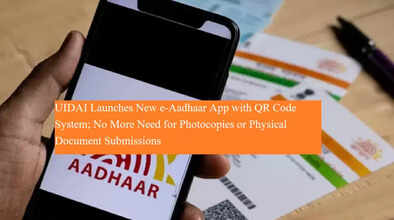UIDAI Launches New e-Aadhaar App with QR Code System; No More Need for Photocopies or Physical Document Submissions

e-Aadhaar App Launched: Say Goodbye to Photocopies as UIDAI Brings QR-Based Aadhaar Verification System
The Unique Identification Authority of India (UIDAI) is set to revolutionize how Aadhaar is used and verified in India. With the rollout of a new e-Aadhaar app and an advanced QR code-based verification system, users will no longer need to carry or submit photocopies of their Aadhaar card for most services. This new system is expected to be fully operational across the country by the end of 2025.
According to UIDAI CEO Bhunesk Kumar, around 2,000 out of 1 lakh Aadhaar verification machines have already been upgraded to support this new system. Once fully implemented, it will eliminate the need for paper documents, making the process more efficient, secure, and user-friendly.
What Is Changing with the New e-Aadhaar System?
The newly launched e-Aadhaar app comes with a built-in QR code scanner and generator, which will allow instant digital verification of your identity. This means individuals will no longer have to carry printed Aadhaar copies for verification at offices, hotels, banks, or other service points.
Key features include:
-
Paperless Aadhaar authentication
-
Instant verification using a scannable QR code
-
Home-based Aadhaar data updates via the app
By November 2025, users will only need to visit Aadhaar centers for biometric verification such as fingerprint scans and iris authentication. All other updates and verifications can be done digitally, saving both time and paperwork.
Easy Aadhaar Updates from Home
The new app will also allow citizens to update their personal details like:
-
Name
-
Address
-
Phone number
This can be done without visiting any Aadhaar Seva Kendra, making the process more convenient and faster.
Moreover, UIDAI is integrating Aadhaar with various government databases to automatically verify identity and residency details. These include:
-
Birth certificates
-
Driving licenses
-
Passports
-
PAN cards
-
Ration cards
-
MGNREGA records
There are also plans to include electricity bills to assist with address verification. This integration aims to reduce manual data entry errors and enhance document reliability.
Focus on Children's Biometric Updates
UIDAI is also taking a proactive step to ensure Aadhaar updates for children. As biometric data changes with age, children are required to update their biometrics:
-
Once between ages 5 and 7
-
Again between ages 15 and 17
To streamline this, UIDAI is collaborating with school boards like CBSE to set up biometric camps in schools. This will help students easily update their records without needing to visit Aadhaar centers separately.
QR Code System Under Testing in Public Spaces
The QR code system is currently being tested in various locations such as registrar offices and hotels. This is to ensure smooth adoption and data security. According to UIDAI, the system is designed with privacy-first protocols—meaning your data will not be shared without your consent.
Why This Matters
Here are the main benefits of the new e-Aadhaar system:
-
No need for photocopies or carrying printed Aadhaar cards
-
Faster updates and verification processes
-
Reduced risk of fraud or identity theft
-
Most updates can be done from home
-
Secure sharing of data only with your permission
Final Takeaway
The launch of the e-Aadhaar app and the QR code verification system marks a major leap in India's digital governance journey. As UIDAI moves toward complete digitization and automation, Aadhaar users can expect quicker, safer, and more accessible services across all sectors. If you haven’t already, it’s time to download the new e-Aadhaar app and stay ahead with your identity management.

